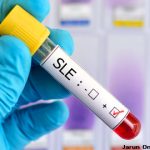 New research has examined the long-term safety of belimumab and potential organ damage in patients with systemic lupus erythematosus (SLE). This open-label, ongoing, extension study included patients (N=738) originally enrolled in the two phase 3 clinical trials, BLISS 52 and BLISS 76, that led to the U.S. Food and Drug Administration’s approval of belimumab. The extension study followed patients for up to nine years.1
New research has examined the long-term safety of belimumab and potential organ damage in patients with systemic lupus erythematosus (SLE). This open-label, ongoing, extension study included patients (N=738) originally enrolled in the two phase 3 clinical trials, BLISS 52 and BLISS 76, that led to the U.S. Food and Drug Administration’s approval of belimumab. The extension study followed patients for up to nine years.1
During the study, patients received intravenous belimumab every four weeks, along with standard SLE therapy. Safety was assessed at each visit. The Systemic Lupus International Collaborating Clinics/ACR Damage Index (SDI) was used to assess safety every 48 weeks. The study continued until belimumab became commercially available in all of the participant’s countries and included an eight-week follow-up period.
The percentage of patients with no change in SDI score from baseline was 94.3% at Year 1, 92.2% at Year 2, 90% at Year 3, 87.9% at Year 4, 87.5% at Year 5, 87.6% at Year 6 and 86.9% at Year 7. At Year 8, 87.7% of patients had no change in SDI score from baseline. This finding indicates low organ damage accrual and a stable safety profile, with no new safety signals for the treatment.
Over time, the incidence of adverse events remained stable or decreased. The most common adverse events were headache (n=205, 28%), nasopharyngitis (n=155, 21%), diarrhea (n=143, 20%), arthralgia (n=136, 19%) and influenza (n=134, 18%). In 9.4% of patients (n=69), the adverse event led to therapy discontinuation or study withdrawal. Eleven deaths were reported, one of which was possibly related to belimumab treatment (cardiogenic shock). Additionally, three instances of suicide attempt/ideation (0.4%) were reported. Infections of special interest included opportunistic infections, tuberculosis, herpes zoster (recurrent and disseminated) and sepsis.
Michele B. Kaufman, PharmD, BCGP, is a freelance medical writer based in New York City and a pharmacist at New York Presbyterian Lower Manhattan Hospital.
Reference
- Van Vollenhoven RF, Navarra SV, Levy RA, et al. Organ damage progression and long-term safety of belimumab (BEL) in patients with systemic lupus erythematosus (SLE): An extension of pivotal phase 3 bliss studies (OP0252). Ann Rheum Dis. 2018 Jun;77:175–176.


